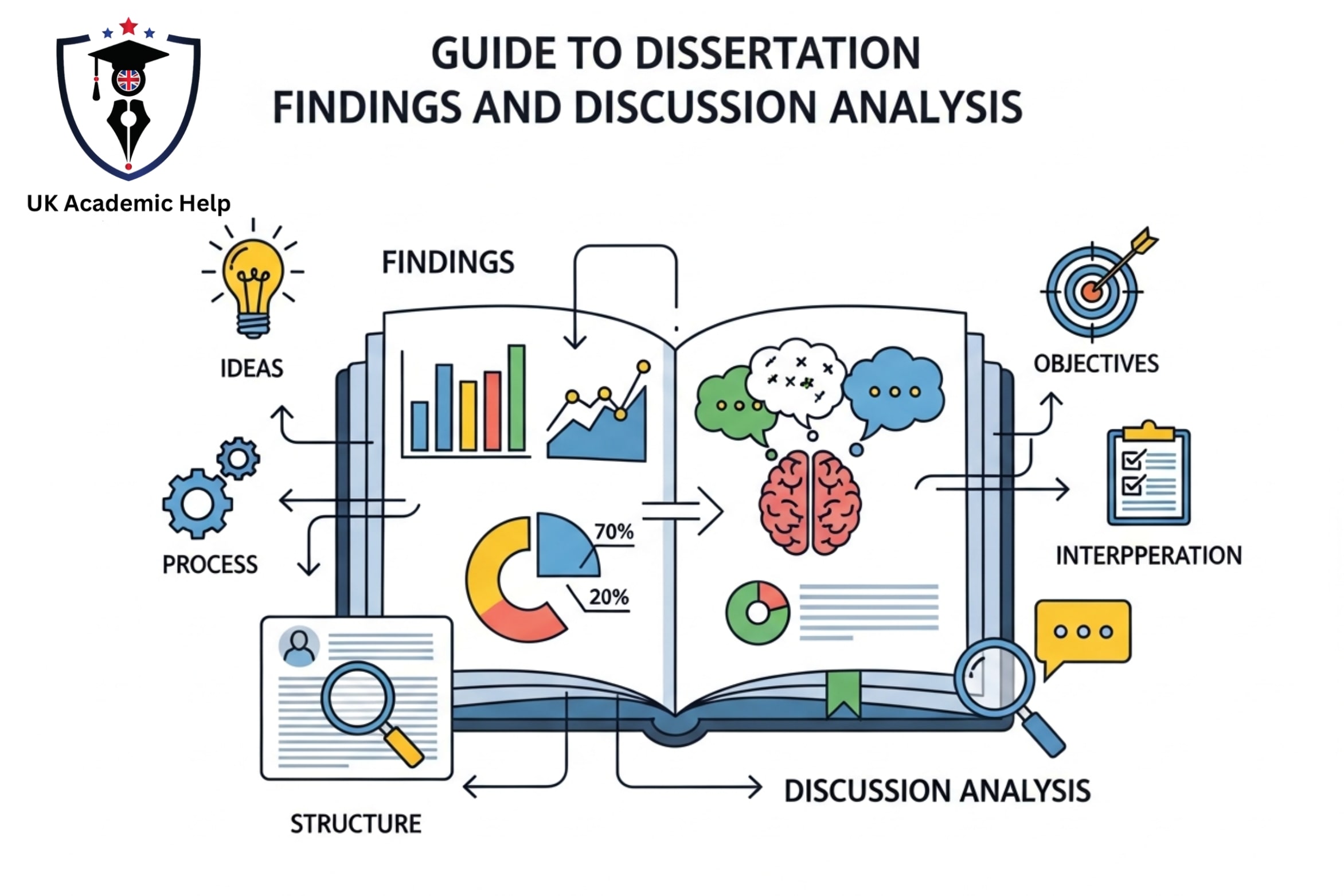Table of Contents
- 1 Introduction
- 2 Why Students Struggle With Their Findings Chapter
- 3 How to Present Results Without Losing Your Argument
- 4 When Analysis Goes Missing in the Discussion Chapter
- 5 Turning Raw Data Into Academic Insight
- 6 What Markers Expect From a Strong Findings and Discussion Section
- 7 The Emotional Pressure Behind Analysing Results
- 8 Bringing Everything Together Before The Conclusion
- 9 FAQs
Summary:
This guide helps students understand how to handle the most demanding part of the dissertation: the findings and discussion. It explains why presenting data is different from analysing it, why markers expect clarity and interpretation, and how to turn raw interviews or SPSS results into meaningful academic insight. The blog also explores emotional pressure, common mistakes, and the subtle skills needed to compare results with literature, highlight contradictions, and build a convincing narrative that supports the final conclusion and overall contribution of the research.
Introduction
There’s a point in every dissertation where the writing suddenly feels heavier. Not because you are tired, but because you finally reach the chapter where you cannot hide behind theories or long literature summaries anymore. The findings and discussion force you to look your data in the eye and explain what it actually means. Many students only realise the pressure of this moment when their supervisor says, “Your results are there, but you have not shown why they matter.”
That single sentence turns what looked like simple reporting into the most demanding part of the dissertation. And the truth is, this chapter defines your grade more than anything else. Markers often skim early chapters but read the findings and discussion slowly, line by line, because this is where they decide whether your research shows real academic understanding or just descriptive writing.
This guide walks you through that crucial shift: from presenting data to analysing it, from describing your participants’ words or SPSS tables to interpreting them, and from repeating what happened to showing why it matters within the academic debate you built earlier.
Why Students Struggle With Their Findings Chapter
Most students do not struggle because they lack data. They struggle because they do not yet know the story their data is trying to tell. It usually begins like this:
You complete your interviews or surveys, export your themes, build your tables or charts, and then open a blank page. Suddenly, you are unsure whether you should explain the results or save explanations for the discussion. You worry about repeating yourself. You wonder whether your supervisor expects thematic analysis or descriptive statistics or something more advanced. You know universities expect clarity and depth, but nobody clearly explains what that looks like.
One student once said, “I know what my data says, but I do not know how to say it academically.” That moment captures the entire struggle. Findings require academic English, accuracy, and confidence. You cannot exaggerate, and you cannot under-explain. You must show what the data reveals without interpreting too early. That balance feels impossible until you see how each part fits the larger purpose of your dissertation.
How to Present Results Without Losing Your Argument
The findings chapter is not about convincing anyone yet. It is about presenting evidence. The argument will come later. But even when you are simply presenting results, you must guide the reader. Think of your research questions as the backbone. Everything you show should relate directly to them.
Markers get frustrated when findings read like a data dump. They want structure, clarity, and progression. If you used qualitative methods, each theme should appear with detail but not overwhelm the reader with long quotations. If you used quantitative methods, your statistics should be correct, labelled, and explained clearly enough that a non-specialist could understand them.
A common mistake is mixing analysis into findings too early. Students jump from “Theme A appeared frequently” to “This shows that participants lacked motivation.” But that interpretation belongs in the discussion. The findings chapter should behave like an organised mirror of your data, not a place to conclude anything.
When Analysis Goes Missing in the Discussion Chapter
Every supervisor recognises the moment a student slides back into description. You can see this in the comments they leave: “develop this”, “go deeper”, “compare results with literature”, “you are repeating your findings”.
The root problem is that many students think the discussion chapter is just a longer conclusion. They restate everything they found without explaining how it fits the academic conversation they mapped earlier.
But the discussion is where your dissertation breathes. It is where your theoretical framework meets your data. It is where you compare your results with existing studies, highlight unexpected findings, point out contradictions, and show how your work contributes to the broader topic.
One student studying mental health support found that the interview results contradicted nearly every article she cited. At first, she panicked. But her supervisor told her that contradictions are not weaknesses. They are opportunities. In the discussion, those contradictions showed that the existing literature was outdated, making her research more valuable.
The discussion shines when you stop describing and start reasoning.
Turning Raw Data Into Academic Insight
To transform your results into meaningful discussion, imagine your data as something alive. Each quote, number, chart, or theme is trying to tell you something. Your task is to connect these messages to bigger academic ideas.
If you used thematic analysis, ask how your themes reflect or challenge the literature. Do they support earlier theories? Do they extend them? Do they contradict them?
If you used SPSS, think beyond the numbers. What does the strength of a relationship mean for your research? What does it suggest about behaviour or attitudes?
Analysis is the moment where your dissertation stops sounding like information and starts sounding like research.
A helpful approach is to pause after each result and ask:
What does this suggest?
Why would this happen?
How do other scholars explain this pattern?
What is surprising here?
What is missing?
These questions pull your mind into interpretation mode. Once you train yourself to answer them naturally, the discussion becomes smoother and more confident.
What Markers Expect From a Strong Findings and Discussion Section
Markers do not expect perfection. They expect control. They want to see that you understand your methodology, can present data accurately, and can interpret it with academic maturity. They look for alignment between your research questions, findings, and conclusions. They notice whether your literature review shaped your expectations and whether your results confirm or challenge those ideas.
A strong discussion chapter behaves like a conversation between your primary research and your literature. Each finding should connect to a scholar, a debate, or a theoretical framework introduced earlier.
Markers tend to reward you for:
• acknowledging limitations honestly
• analysing results instead of repeating them
• linking evidence to literature
• interpreting unexpected outcomes
• writing with clarity instead of complexity
Many students think academic English must sound heavy or complicated. But markers prefer clarity, precision, and insight.
The Emotional Pressure Behind Analysing Results
Students rarely talk about the emotional side of this chapter, but it affects writing more than they realise. Many avoid writing findings because they fear their results are not strong enough. Others delay the discussion because their data did not match expectations. Some worry their themes seem too simple. Some worry their SPSS results look basic.
These feelings silently push students into descriptive writing. They stay safe instead of analytical. They list instead of interpret.
One student waited a full week before starting the discussion because she was convinced her findings were not academic enough. But the strength of your dissertation is not based on how fancy your data looks. It is based on how thoughtfully you explain it. Even simple patterns can become meaningful when discussed with confidence and academic support.
Acknowledge the pressure, and the writing becomes clearer.
Bringing Everything Together Before The Conclusion
The findings and discussion create the moment where your dissertation finally comes full circle. Your literature review shapes your expectations. Your methodology shapes your evidence. Your evidence shapes your interpretation.
Before writing your conclusion, revisit your research questions. Check whether your findings truly answer them. Make sure your discussion connects each answer to literature, theory, or previous debates. This step alone stops repetition and strengthens the entire final chapter.
Students who do this produce more convincing dissertations. Students who skip it often repeat themselves or introduce new ideas too late.
FAQs
How can I avoid repeating my findings in the discussion?
By focusing on why results happened, not what happened. Connect them to existing literature.
How do I know my analysis is strong enough?
If you compare, interpret, question, and explain implications, you are analysing.
Should I mention limitations in findings or discussion?
Briefly in the discussion, then more clearly in your conclusion.
Can unexpected results still be valuable?
Definitely. They often lead to the strongest analytical moments.








Leave A Comment